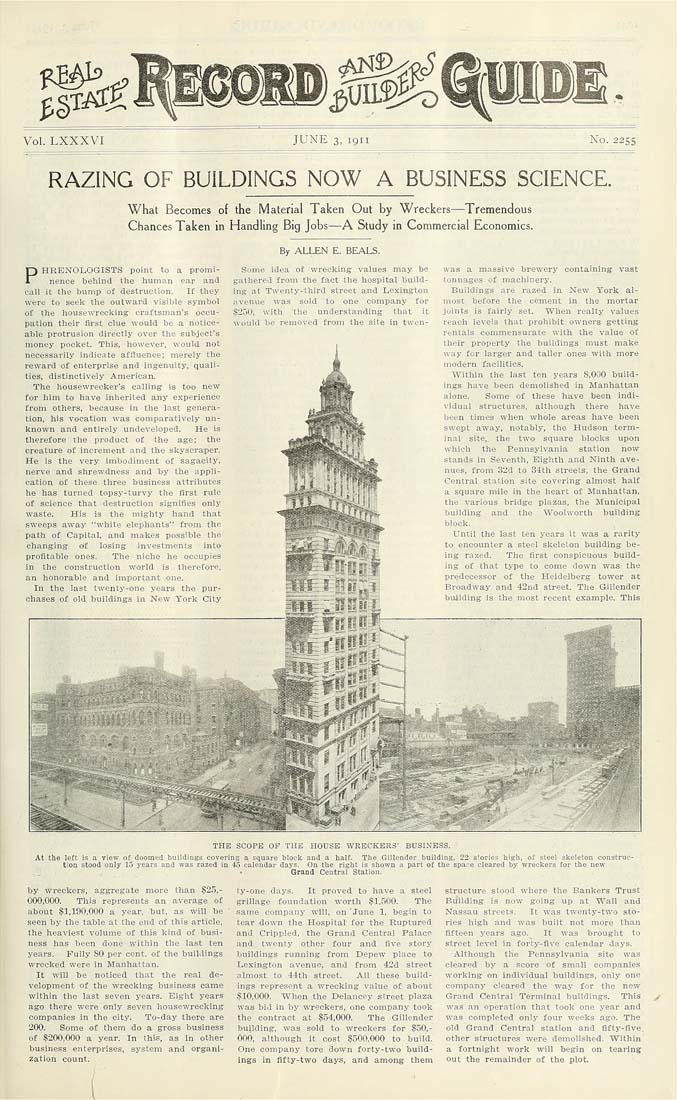Columbia University Libraries Digital Collections: The Real Estate Record
Use your browser's Print function to print these pages.
Real estate record and builders' guide: v. 87, no. 2255: June 3, 1911

Text version:
Please note: this text may be incomplete. For more information about this OCR, view About OCR text.
Vol. LXXXVI JUNE 3, 1911 No. 2255 RAZING OF BUILDINGS NOW A BUSINESS SCIENCE. What Becomes of the Material Taken Out by Wreckers—Tremendous Chances Taken in HandHng Big Jobs—A Study in Commercial Economics. PHRENOLOGISTS point to a promi- nence behind the human ear and call it the bump of clestruclion. II! they were to seek the outward visitile sj'inbol of the housewrecking craftsman's occu¬ pation their first clue would he a notice- aljle protrusion directly over the subject's money poclcet. This, however, would not necessarilj' indicate affluence; merely tlie reward of enterprise and ingenuity, qtiali- ties, distinctively American. The hotisewrecker's calling' is too new for him to have inherited any experience from others, because in the last genera¬ tion, his vocation was comparatively un¬ known and entirely undeveloped. He is tlierefore the product of the agre; the creature of increment and the skyscraper. He is the very imliodinient of sagacity, nerve and shrewdness and by the appli¬ cation of these three business attributes he has turned topsy-turvy the first rule of science that destruction signifies only waste. His is the mighty hand that sweeps away "white elephants" from the path of Capital, and makes possible the changing of losing investments into profitable ones. The niche he occupies in the construction world is therefore, an honorable and important .one. In the last twenty-one years the pur¬ chases of old buildings in New Tork City By ALLEN E. BEALS. Some idea of wrecking values may be gathered from the fact the hospital build¬ ing at Twenty-third street and Lexinston avenue was sold to one company for $250, with the understanding that it would be removed from the site in twcn- was a massive brewery containing vast tonnages of machinery. Buildings are razed in New York al¬ most before tlie cement in. the mortar joints is fairly set. "When realty values reach levels that prohibit ow-ners getting rentals commensurate with the value of their property the buildings must make way for larger and taller ones with more modern facilities. Within the last ten years S,O0O build¬ ings have been demolished in IVIanhattan alone. Some of these have been indi¬ vidual structures, although there have been times ivhen whole areas have been swept away, notably, the Hudson term¬ inal site, the two square blocks upon which the Pennsylvania station now stands in Seventh, Eighth and Ninth ave¬ nues, from 32d to 34th streets, the Grand Central station site covering almost half a square mile in the heart of Manhattan, the various bridge plazas, the Municipal building and the Woolworth building block. Until the last ton years it was a rarity to encounter a steel skeleton building be¬ ing razed. The flrst conspicuous build¬ ing of that type to come down was the predecessor of the Heidelberg tower at Broadway and 42nd street. The Gillender building is the most recent example. This THE SCOPE OF THE HOUSE WRECKERS' BUSINESS. ■ At the left is a view of doomed buildings covering a square block aod a half. Tbe Gillender building, 22 stories high, of steel skeleton construc¬ tion stood only 15 years and was razed in -15 calendar days. Oq the right is shown a part of the spa.ce cleared by wreckers for the new Grand Central Station. by wreckers, aggregate more than $25.- 000,000. This represents an average of about $1,190,000 a year, but, as will be seen by the table at the end of this article, the heaviest volume of this kind of busi¬ ness has been done within the last ten years. Fully SO per cent, of the buildings wrecked were in Manhattan. It will be noticed that the real de¬ velopment of the wrecking business came within the last seven years, Eight years ago there were only seven housewrecking companies in the city. To-day there are 200. Some of them do a gross business of $200,000 a year. In this, as in other business enterprises, system and organi¬ zation count. ty-one days. It proved to have a steel grillage foundation worth $1,500. The same company will, on June 1, begin to tear down the Hospital for the Ruptured and Crippled, the Grand Central Palace and twenty other four and five story buildings running from Depew place to Lexington avenue, and from 42d street almost to 44th street. All these build¬ ings represent a Ti'recking value of about $10,000. When the Delancey street plaza was bid in by wreckers, one company took the contract at $54,000. The Gillender building, was sold to wreckers for $50,- 006, although it cost $500,000 to build. One company tore down forty-two build¬ ings in fifty-two days, and among them structure stood where the Bankers Trust Building is now going up at Wall and Nassau streets. It was twenty-two sto¬ ries iiigh and was built not more .than flfteen years ago. It was brought to street level in forty-five calendar days. Although tlie Pennsylvania site was cleared by a score of small companies working on individual buildings, only one company cleared the way for the new Grand Central Terminal buildings. This was an operation that took one year and was completed only four weeks ago. The old Grand Central station and fifty-five, other structures were demolished. Within a fortnight work will begin on tearing Out the remainder ol the plot.